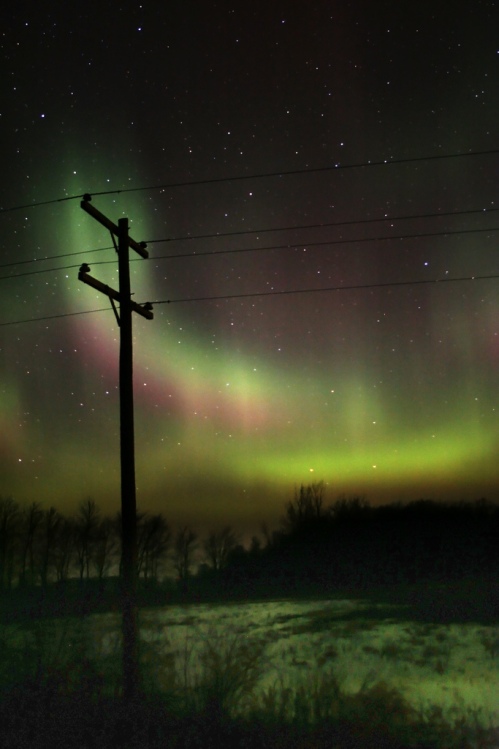Matt took this picture (and a few others) on December 15, 2006. Just for fun, I thought I’d link to a slideshow of “aurora” photos taken on December 15th of 2006 on Flickr (there are a lot of them – I even have one in there!)
10 Stunning Images and Legends of the Northern Lights (Aurora Borealis) notes that in Latvian folklore the aurora borealis, especially if red and observed in winter, are fighting souls of dead warriors. The images are indeed stunning.
If you’re not buying that dead Latvian warrior thing, the most excellent Aurora FAQ from the Geophysical Institute at the University of Alaska has an answer to what makes the different colors of the northern lights (aurora borealis). They explain that the composition and density of the upper atmosphere at the altitude of the aurora are behind it all.
Basically, the aurora excites atoms & molecules (as well as photographers) and as that atom or molecule returns to the ground state, it sends out a photon with a specific energy.
This energy depends on the type of atom and on the level of excitement, and we perceive the energy of a photon as color. The upper atmosphere consists of air just like the air we breathe. At very high altitudes there is atomic oxygen in addition to normal air, which is made up of molecular nitrogen and molecular oxygen. The energetic electrons in aurora are strong enough to occasionally split the molecules of the air into nitrogen and oxygen atoms. The photons that come out of aurora have therefore the signature colors of nitrogen and oxygen molecules and atoms. Oxygen atoms, for example, strongly emit photons in two typical colors: green and red. The red is a brownish red that is at the limit of what the human eye can see, and although the red auroral emission is often very bright, we can barely see it.
Photographic film has a different sensitivity to colors than the eye, therefore you often see more red aurora on photos than with the unaided eye. Since there is more atomic oxygen at high altitudes, the red aurora tends to be on top of the regular green aurora. The colors that we see are a mixture of all the auroral emissions. Just like the white sunlight is a mixture of the colors of the rainbow, the aurora is a mixture of colors. The overall impression is a greenish-whitish glow. Very intense aurora gets a purple edge at the bottom. The purple is a mixture of blue and red emissions from nitrogen molecules.
The green emission from oxygen atoms has a peculiar thing about it: usually an excited atom or molecule returns to the ground state right away, and the emission of a photon is a matter of microseconds or less. The oxygen atom, however, takes its time. Only after about a 3/4 second does the excited atom return to the ground state to emit the green photon. For the red photon it takes almost 2 minutes!
Check the Aurora FAQ for much more information about this wonderful phenomenon and get more posts about the Northern Lights from Michigan in Pictures!


Great information! Thanks for sharing this.
LikeLike